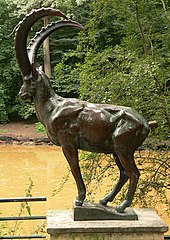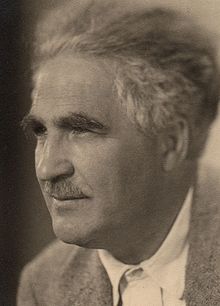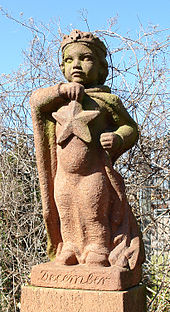Ernst Gorsemann
Ernst Gorsemann (born February 15, 1886 in Bremen , † July 19, 1960 in Bremen) was a German sculptor and director of the Nordic Art Academy in Bremen. Between 1914 and 1960 he created numerous sculptures , monuments , gravestones and medals .
biography


Ernst Gorsemann grew up in poor circumstances in a working class family in the Walle district of Bremen . His father was a construction worker and died early; he had to support his mother with auxiliary work while still at school. At the age of 14, he first learned the mason trade , trained a. a. by visiting the technical center and became a site manager at the age of 18. His first work was construction drawings for the first water closets in Bremen.
But his interest was always more in sculpture. In 1910 he attended the Kassel Art Academy , where he studied with Carl Hans Bernewitz . On the recommendation of Mayor Hermann Hildebrand , he received a scholarship and was accepted into his master class by Louis Tuaillon in Berlin in 1913 . At the beginning of the First World War he volunteered, was initially a medic and was later assigned to design military cemeteries. After the war, after Tuaillon's death, he lived on his own, from his work. He mainly creates portrait busts and gravestones as commissioned work.
In April 1934, Gorsemann was appointed professor of sculpture at the Nordic Art College in Bremen . At the end of 1934 he took over the management of the school in place of Fritz Mackensen until he was replaced by Carl Horn ( Rudolf Hess's father-in-law ) in February 1935 . In the following years he designed a number of monuments and sculptures. 1938/1939 he was a member of the committee for the restoration of the Bremen Roland .
After the Second World War , Gorsemann became deputy director of the art college, but soon fell ill and was unable to work. In 1946 he was retired for health reasons. Until his death, he continued to work without receiving any public contracts and wrote his memoirs “From morning to noon”. In 1960 Gorsemann was buried in the cemetery of his home community in the Horn district of Bremen . He had made his tombstone himself. His house and workshop at Leher Heerstraße 127 was lived in by his daughter until it was demolished.
plant
In 1924 Gorsemann received the first prize for his design of a monument for the Hanoverian royal ulans and was commissioned with the execution. The equestrian sculpture was set up in 1927 in the Eilenriede in Hanover.
On October 6, 1933, the Bremen Senate decided to commission Gorsemann to design a memorial in honor of those who fell in the First World War . In December he presented a design together with the architect Wiepking. On the Altmannshöhe in the ramparts , a circular wall made of 10,000 bricks with the names of the fallen was to be built and a sculpture was to be erected. On October 13, 1935, the inauguration took place in the presence of General von Fritsch, Mayor Karl Heider and Regional Bishop Heinz Weidemann .
On December 1, 1937, he received the gold medal at the Paris World Exhibition for his sculpture The Wisent on the roof garden of the German House . The sculpture then stood in the exhibition Bremen - Keys to the World and was set up on August 13, 1940 in the Rhododendron Park.
In June 1938 a memorial stone designed by him for the creator of the Bürgerpark , Wilhelm Benque , was set up in the oak grove near the Melchers pavilion.
In 1939 an equestrian statue designed by him for the fallen soldiers of the First World War was erected in the choir of the Martinikirche. The grave slab of Archbishop Adalbert's grave in the east crypt of the cathedral also comes from Gorsemann .
His last unfinished work, The Family , was placed in the Teerhof (Bremen) in 1999 .
Proximity to National Socialism
Gorsemann's closeness to National Socialism is controversial. His ties to his homeland, right up to the conscious use of North German clay, his idealizing naturalism, his striving for perfection, internalization, spirit and soul in his work corresponded to the zeitgeist of the National Socialists . His works literally offered themselves to the ideals of the National Socialists, and he was ready to accept this offer without criticism and to produce numerous commissioned works including a bust of Gauleiter Carl Röver . On the other hand, he also created busts of people who were far removed from National Socialism, such as Helene Lange or Gertrud Bäumer . During the Weimar Republic he belonged to the Freemasons and was a member of the Rotary Club until it was dissolved . As a devout Christian, he wrote writings of mystical and theosophical content. In 1933 he hid the interior minister Carl Severing, who was on the run . Gorsemann belonged to the Reich Chamber of Fine Arts from 1934 to 1945 . He was the only non-party member at the art school. In 1938, the Gestapo investigated and reprimanded him on the basis of a complaint from students at the art college.
After the Second World War, the British military government classified him in the group of teachers whose remaining in the civil service should be checked again. On the advice of Wilhelm Kaisen and Senator Christian Paulmann, Gorsemann gave up teaching for health reasons and was retired in 1946. In 1948 the Bremen Spruchkammer classified him as not encumbered.
Honors
- Senate Medal for Art and Science of the Free Hanseatic City of Bremen
- In 1968 a street in the Bremen district of Kattenturm was named after him.
plant
Sculptures and monuments
- Cenotaph for the people of Bremen who fell in World War I , Altmannshöhe in den Wallanlagen , Bremen, 1935, with a sculpture of mother and children, 1936, damaged in the war and replaced in 1945 by a new production by G.; damaged statue now in the garden of the house (see picture)
- "Runner", bronze, Reichssportfeld in Berlin (fallen after Prince Friedrich Carl of Prussia, 1917)
- Cenotaph for the fallen of the Hanoverian Königs-Uhlans, in the Eilenriede in Hanover, 1927
- Cenotaph for the fallen of the King's Hussars in Bonn (destroyed)
- Praying rider in the Martinikirche in Bremen (fired clay; destroyed)
- "Mother" in the Bremen Cathedral (fired clay)
- “Look out” and “readiness”, building sculptures for buildings of the Navy in Emden
- Eagle for a Wehrmacht system in Westphalia
- Horse fountain for village squares in the east (1st prize in a competition by the Reichsführer of the SS)
- Draft of a memorial for the Bremen dialect poet Georg Droste (destroyed)
- Cycle of the seasons and garden pictures of the twelve months in the garden of the Egestorff Foundation
- Deer fountain in the Bremen ramparts in honor of Mayor Hermann Hildebrand (1933; bronze and granite)
- Bronze sculpture of a deer in the green area on Schleusenstrasse in Oldenburg (1933; stolen 2010)
- Götz grave monument in the Osterholz cemetery
- St. Michael (fired clay)
- Bronze sculpture of an ibex (around 1939; acquired by Reichsfeldmarschall Hermann Göring )
- Bronze sculpture The Wisent , 2.30 m high, created before October 1935, then placed in front of the Berlin Künstlerhaus, moved to the courtyard of the Bremen Art School on October 27, 1935 , at the World Exhibition in Paris in 1937, in the Rhododendron Park in Bremen since August 13, 1940
- Clinker ceramic sculpture of a bear in the Bremen ramparts
- Commemorative plaque for the first non-stop flight across the Atlantic, now in Bremer Böttcherstraße
- Baptismal font in the crypt of Bremen Cathedral
- Fired clay crucifix in the St. Petri Church in Hamburg
- Relief "The Emigrants", Foundation of the City of Bremen for the Church of the Low German in Brooklyn
- Stone sculpture Die Familie (last, unfinished work; installed at Bremen Teerhof in 1999 )
Busts
- Johann Focke , portrait bust made of pear wood, 1923, in the Focke Museum Bremen
- Dietrich Schäfer (historian), made of terracotta, in the Focke Museum Bremen
- Paul Deussen (philosopher and Indologist), 1915
- Arnold Duckwitz (1802–1881), from terracotta, 1939
- Ernst Grohne , made of terracotta, in the Focke Museum Bremen
- Helene Lange (teacher), made of pear wood, destroyed
- Gertrud Bäumer (women's rights activist and social politician)
- Erwin Guido Kolbenheyer (novelist, playwright and poet), made from fired clay
- Max Delbrück (chemist)
- Max Hartmann (biologist), made of baked clay and cast bronze
- Hans Hartmann (altitude physiologist), made of baked clay, stands with his granddaughter
- Carl Correns (botanist)
- Carl Röver (Gauleiter and Reichsstatthalter), in the Oldenburg state parliament building, 1938
- Eugen Diederichs (publisher)
- Child's head
- Bust of his mother at the age of 60, 1914
Tombstones
- Tomb of the Fischer family in Arolsen (first commissioned work)
- Grave slab for the grave of Archbishop Adalbert von Bremen in the Bremen Cathedral
- Grave sculpture for Georg Droste , made of fired clay
Medals
- Plaque with the relief profile of Hermann Hildebrand
- Olympic medal 1936
- Medal for Art and Science
- Senate plaque for Rudolf Alexander Schröder
- Colonel von Engelbrechten
- Cologne fighting games
- Bremen Senate Medal
Gallery of works by Ernst Gorsemann
Fonts
- From morning to noon. Rauschenbusch, Berlin 1949.
literature
- Historical Society Bremen (Ed.), Wilhelm Lührs (Ed.): Bremische Biographien 1912–1962. Bremen 1969.
- Michael Koppel: Horn-Lehe-Lexikon. Edition Temmen , Bremen 2012, ISBN 978-3-8378-1029-5 .
- Parishes Horn I and II, local office and citizens' association Horn-Lehe (Ed.): 800 years of Horn-Lehe.
- Lothar Heft: The Rhododendron Park Bremen 1936-1986. A park in Bremen. Bremen 1986.
- Kai Artinger: "Germanic forest cattle" and rhododendrons. The story of Bremen's most famous free sculpture and the rhododendron park during National Socialism. In: Workers' Movement and Social History , Issue 26 (2012), pp. 49–78, especially pp. 55–58.
Web links
Individual evidence
- ↑ For the ideological implications of this monumental sculpture, see the article by K. Artinger.
- ↑ Beate Mielsch: Monuments open sculptures fountains in Bremen 1800 - 1945 , Bremen 1980, pp. 45 and 55
- ↑ "The Family" by Ernst Gorsemann (1999) Teerhof . In: monuments, works of art and sculptures . Marketing FOCUS Germany GmbH. Retrieved December 13, 2013.
- ↑ For the ideological implications of this monumental sculpture, see the article by K. Artinger.
- ↑ Beate Mielsch: Monuments open sculptures fountains in Bremen 1800 - 1945 , Bremen 1980, pp. 45 and 55
| personal data | |
|---|---|
| SURNAME | Gorsemann, Ernst |
| ALTERNATIVE NAMES | Gorsemann, Ernst Moritz |
| BRIEF DESCRIPTION | German sculptor |
| DATE OF BIRTH | February 15, 1886 |
| PLACE OF BIRTH | Bremen |
| DATE OF DEATH | July 19, 1960 |
| Place of death | Bremen |












